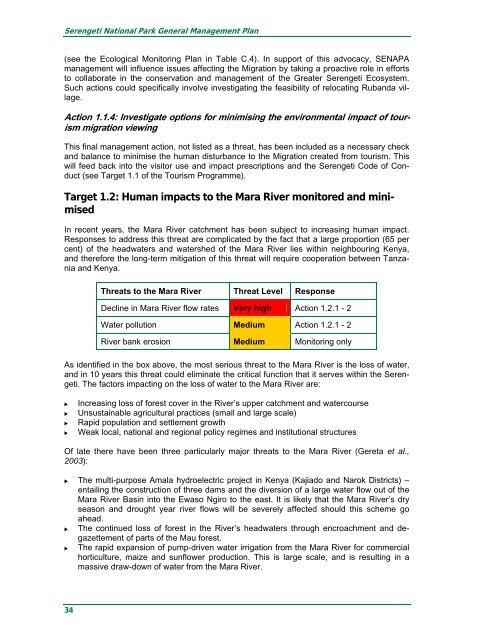Serengeti General Management Plan
Serengeti General Management Plan
Serengeti General Management Plan
- TAGS
- serengeti
- www.zgf.de
Create successful ePaper yourself
Turn your PDF publications into a flip-book with our unique Google optimized e-Paper software.
<strong>Serengeti</strong> National Park <strong>General</strong> <strong>Management</strong> <strong>Plan</strong><br />
(see the Ecological Monitoring <strong>Plan</strong> in Table C.4). In support of this advocacy, SENAPA<br />
management will influence issues affecting the Migration by taking a proactive role in efforts<br />
to collaborate in the conservation and management of the Greater <strong>Serengeti</strong> Ecosystem.<br />
Such actions could specifically involve investigating the feasibility of relocating Rubanda village.<br />
Action 1.1.4: Investigate options for minimising the environmental impact of tourism<br />
migration viewing<br />
This final management action, not listed as a threat, has been included as a necessary check<br />
and balance to minimise the human disturbance to the Migration created from tourism. This<br />
will feed back into the visitor use and impact prescriptions and the <strong>Serengeti</strong> Code of Conduct<br />
(see Target 1.1 of the Tourism Programme).<br />
Target 1.2: Human impacts to the Mara River monitored and minimised<br />
In recent years, the Mara River catchment has been subject to increasing human impact.<br />
Responses to address this threat are complicated by the fact that a large proportion (65 per<br />
cent) of the headwaters and watershed of the Mara River lies within neighbouring Kenya,<br />
and therefore the long-term mitigation of this threat will require cooperation between Tanzania<br />
and Kenya.<br />
34<br />
Threats to the Mara River Threat Level Response<br />
Decline in Mara River flow rates Very high Action 1.2.1 - 2<br />
Water pollution Medium Action 1.2.1 - 2<br />
River bank erosion Medium Monitoring only<br />
As identified in the box above, the most serious threat to the Mara River is the loss of water,<br />
and in 10 years this threat could eliminate the critical function that it serves within the <strong>Serengeti</strong>.<br />
The factors impacting on the loss of water to the Mara River are:<br />
� Increasing loss of forest cover in the River’s upper catchment and watercourse<br />
� Unsustainable agricultural practices (small and large scale)<br />
� Rapid population and settlement growth<br />
� Weak local, national and regional policy regimes and institutional structures<br />
Of late there have been three particularly major threats to the Mara River (Gereta et al.,<br />
2003):<br />
� The multi-purpose Amala hydroelectric project in Kenya (Kajiado and Narok Districts) –<br />
entailing the construction of three dams and the diversion of a large water flow out of the<br />
Mara River Basin into the Ewaso Ngiro to the east. It is likely that the Mara River’s dry<br />
season and drought year river flows will be severely affected should this scheme go<br />
ahead.<br />
� The continued loss of forest in the River’s headwaters through encroachment and degazettement<br />
of parts of the Mau forest.<br />
� The rapid expansion of pump-driven water irrigation from the Mara River for commercial<br />
horticulture, maize and sunflower production. This is large scale, and is resulting in a<br />
massive draw-down of water from the Mara River.
















